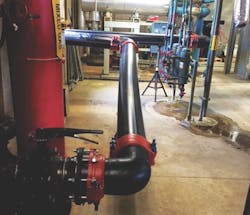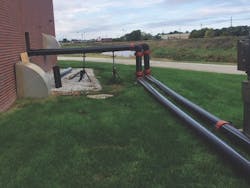About the author:
Steve Morehead is HDPE Specialist for Victaulic. Moorehead can be reached at [email protected].
Bypassing areas of pipe that need repair or maintenance is commonplace in wastewater treatment plants (WWTPs) where the facility’s footprint is large and space for construction is not a concern. Normally, when a bypass needs to be installed, the line is excavated and prepared so a length of steel pipe can be affixed to the working line above and below the affected segment to allow fluids to be diverted while maintenance or repairs are carried out on the line.
The bypass installation at the Theresa WWTP in Lincoln, Neb., would have been a routine job had the decision been made to follow the usual procedure. What sets this project apart is the decision to use high-density polyethylene (HDPE) pipe and to replace flanged connections with specialty couplings.
Theresa WWTP
More than 1,000 miles of sanitary sewer lines and 15 pumping stations convey wastewater to two municipal water resource recovery facilities at the Theresa Street Water Resource Recovery Facility. This WWTP, which sits on 51 acres in the north central section of the city, has a maximum capacity of 28 million gal per day (mgd), recovering an average of approximately 20 mgd per day, with an additional facility in the northeastern section of the plant recovering 5 million gal.
Operations and maintenance staff operate and maintain more than 5,200 pieces of equipment on site, including equipment used for screening, pumping, grit removal, primary clarification, biological treatment, secondary clarification, disinfection, solids digestion, solids dewatering and land application.
Organic solids collected from the primary clarifiers and waste solids from the secondary clarifiers are pumped to anaerobic digesters where microorganisms break down the solids into a more stable form. At the Theresa Street facility, methane is used as fuel by two enginators to produce electrical power and provide heat for the digestion process. The enginators generate as much as 900 kW of power while maintaining a temperature of 98°F in the three digesters, reducing the need for electricity produced from fossil fuels and consuming the methane gas which otherwise would be wasted.
During an inspection at the plant, a leak was discovered in the buried lines transporting water at 180°F into the digesters. The line could not be taken out of service because doing so would interrupt flow to the digesters, which would cause a buildup of sludge. The obvious decision was to build a bypass so work could be done with the line empty; the less obvious decision was to build the bypass using HDPE pipe.
New Materials, New Approach
According to Shane Tucker, project manager for Hayes Mechanical, dealing with a leak of this type is not unusual. “It was only heated water that was leaking,” he said. There were no biohazards or contamination risks, “but with this line out of service, the digesters would be unable to work. We didn’t have a lot of time.”
Traditional solutions would have used stainless steel pipe and flanged connections because the water in the line was 180°F, which regular HDPE pipe cannot accommodate. Using an HDPE solution meant using special pipe rated for a temperature 40°F higher than standard HDPE pipe. Even with the specialty pipe, Tucker said, “the productivity enhancement and economic advantage of using HDPE pipe and Installation-Ready Victaulic Style 905 couplings for this project” made it a suitable choice.
Choosing mechanical couplings meant Tucker and his team could avoid fusing the HDPE bypass piping altogether, which reduced project costs and installation times. Fusing equipment is expensive to rent, and it would have to be repositioned multiple times to perform the fusions necessary to ensure the integrity of the bypass.
Executing Installation
To install the bypass, it was necessary to shut down flow through the pipe while T’s were cut into the steel pipe and welded in place. This shutdown lasted only one day. Butterfly valves were installed so the flow could be isolated. Using these valves eliminated the need for a second shutdown.
Two 8-in. HDPE piping bypass lines were installed to circumvent the leaking area. The lines were secured using Victaulic Style 905 couplings, which do not require grooving. Their Installation-Ready construction allows the coupling to be stabbed into place, a process that Tucker believes takes his team approximately 15 minutes per coupling. In contrast, each fusion weld joint takes around 2.5 hours to complete, he said.
This project marks the first time this type of HDPE pipe and Victaulic Style 905 couplings were used for this type of installation.
“Using this pipe and fittings made the project much easier than it would have been using other components,” Tucker said.
Next Steps
Using Victaulic Installation-Ready components designed for simplicity and safety, the bypass was performed quickly and with considerably less risk than would have been possible with a different approach. By using safe installation methods and innovative couplings, it was possible to carry out the work more quickly and efficiently than would have been possible using traditional steel pipe and flange connectors.
By refusing to fuse, Hayes Mechanical demonstrated mechanical couplings are a viable solution for joining HDPE pipe. They are fast, durable and efficient, which in this case led to significant cost savings and reductions in completion times for the contractor.

